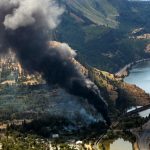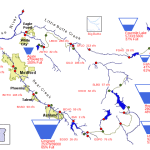Ashland and the Two Fronts in the War Against Climate Change

Sixteen years after the release of “An Inconvenient Truth”, most of the world has finally come to understand that climate change is upon us. Finally, most of the world has realized that life on Earth as we know it will be radically transformed, no matter what happens. Whether the human race will be able to survive the changes that are coming is an open question.
But being human beings, we are hard wired to face our problems and do our best to deal with them, if not solve them outright. The first step is to recognize the problem. The second step is to understand the problem. The third step is to make plans to solve or minimize the problem. The fourth step is to act.
Most of us in the developed world are engaged in the third AND fourth steps, planning and action. That is as it must be, because the situation is changing rapidly. Each year, the estimated arrival time of disastrous consequences come closer, and the estimates of that arrival time are revised to be ever closer.
At the beginning of the century, some were talking about catastrophic effects at the end of the century. Ten years ago some were talking about catastrophic effects in 2050. Now, many are talking about irreversible disastrous effects in 2030. No one knows how quickly those effects will arrive and how bad they will be.
There is no question that the time to act is NOW. The questions is: HOW?
The Two Fronts
I personally feel that although there are many things we can do as individuals and a society to slow the progress of climate change, it is too far advanced. We are caught in self-reinforcing feedback loops. The obvious analogy is the giant snowball rolling downhill which grows bigger and rolls faster with every second. Sadly, we were too slow to recognize the problem and too slow to understand it. Now we are facing effects that are irreversible.
This is not a popular view. It is contrary to human nature to admit that we cannot solve any problem we face. We have been successful in so many endeavors, technology has solved so many problems for us in the past. But those successes have come at a cost to the environment, and the results are becoming clearer each day. Every problem we solve begets other, new, unforeseen and unintended consequences.
There are two broad, general ways to look at the fight against climate change. The first is how to prevent it from becoming any worse. That is what most people have been concentrating on. The second is how to deal with the inevitable effects, and how to survive them. How one views the problem informs the way they will approach the solutions.
To me, it is clear. We must do everything we can to prevent the situation from getting worse. But at the same time, we must now urgently plan for how to respond to the inevitable. We must start planning right now how we will survive as a species.
Life will go on, as it has for millions of years. Living organisms will adapt or perish. Some life forms have thrived throughout all of the changes the planet has endured. Many others have gone extinct. If the effects of the changing climate become too severe, as now seems inevitable, will civilization as we know it survive? Will we as a species survive?
Think Globally, Act Locally
Almost everything we do as a civilization depends upon using energy. All forms of energy consumption create heat and emissions and pollution. There is no denying the physics. There is no free lunch. All forms of energy production require extraction of natural resources, no matter how “clean” they can be considered to be. The systems have to be considered in totality.
There’s not much we can do to limit the use of fossil fuels in the developing world. We can try to influence others, but ultimately, they will make their own decisions. Unfortunately, for many of them economic considerations often take precedence over everything else. And despite our best efforts, it appears that the poorer nations often feel, correctly or not, that they have no choice, or at least limited options. We have to concentrate on what we can do ourselves.
As a nation, we are finally coming to the realization that we’re facing an emergency. We are finally taking actions at the national level to reduce our emissions. We are finally recognizing that denial is no longer an option. At least most of us feel that way. Those heavily invested in extractive industries are still fighting to save their paychecks.
We each individually would be wise to do everything within our power to reduce our pollution. Notice I said pollution, not just emissions, since carbon emissions are just one kind of pollution, the one that is contributing the most to climate change, at least in our current understanding. But every form of pollution—water pollution, industrial pollution, nuclear pollution, hazardous and solid waste pollution– they all pose a threat to life on earth. They all must be addressed and mitigated.
We as a city need to decide how to deal with pollution and climate change. There are many things we can do. And therein lies the rub: what should we do?
City Council
We have one sitting councilor, Tonya Graham, who has dedicated herself to fighting climate change. We’ve seen it in every one of her votes, every one of her statements. She is executive director of a non-profit institute that is dedicated to fighting climate change. She is running for reelection this year. We’ve had four years to examine her record and her conduct as a councilor.
We have one other candidate for council, Bob Kaplan, who says he has dedicated his life to fighting climate change. He is on numerous committees and organizations that concentrate on climate change. All of his statements on the campaign trail to date focus on the need to focus on reducing carbon emissions, mostly by changing out appliances.
Both of these candidates see everything about the city through the lens of climate change. It colors all of their words and deeds. That is a good thing, but only up to a point. It cannot blind one to all of the other issues facing the city, of which there are many. As with everything in life, there must be a balance.
Tonya Graham has shown no awareness of the need for that balance. She does everything she can to fight for marginal reductions in emission, while ignoring the other ramifications of her suggestions. Likewise, Bob Kaplan is laser focused on reducing emissions and using city resources to achieve his goals.
For these reasons, I believe that Tonya Graham and Bob Kaplan are the wrong choices for council this year. We need councilors who have a more holistic view of our situation, who aren’t beholden to their ideological beliefs. We need councilors who will not view every issue as a way to combat marginal carbon emissions. Tonya and Bob should continue to pursue their efforts in their institutes and committees. But their lopsided view of the city’s many problems have no place on the council at this time.
The Bottom Line
Make no mistake, reducing emissions are important actions, but not to the exclusion of the other side of the problem: survival. What are we doing as individuals and a city to mitigate the effects of climate change? Reducing personal and municipal emissions are worthwhile goals, but they are marginal at best. In the long run, they will not make much difference. We’ve gone too far, too long not dealing with the problem. That giant snowball is probably unstoppable.
That is not to say that we shouldn’t continue to do all we can. But to me, the best thing we can do now is prepare ourselves for what is to come. It is time to concentrate more on how to counter the effects of climate change, how to make our environment more livable and survivable as these overwhelming environmental changes occur.
The horse has already left the barn. And the barn is literally on fire. Let’s not be distracted trying to get the horse back in there. Let’s concentrate on saving the farm.
Image: NASA’s Scientific Visualization Studio





